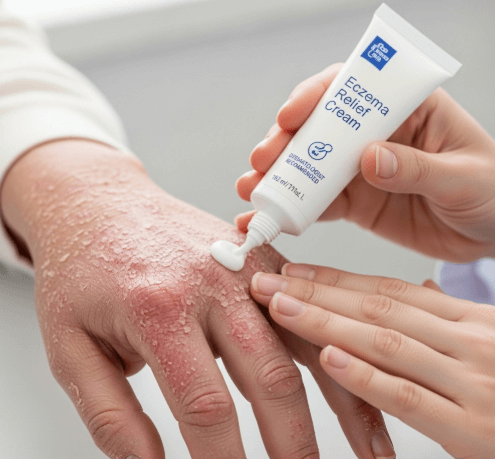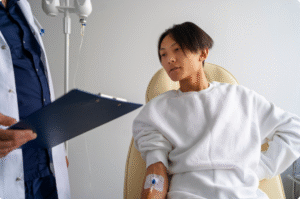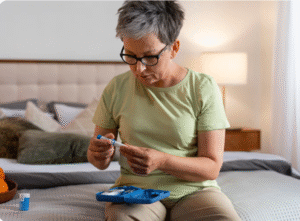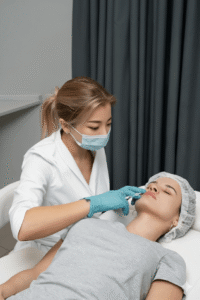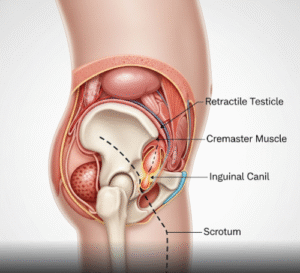➤ What it is
Hand Eczema, also called hand dermatitis, is a chronic inflammatory skin condition that affects the hands. It is characterized by redness, itching, dryness, scaling, cracks, and sometimes painful blisters. Unlike common dry skin, hand eczema is often persistent, recurrent, and more severe, impacting daily life and work.
Hand eczema may arise from:
- Atopic predisposition (people with atopic dermatitis are more prone),
- Irritant contact dermatitis (frequent washing, exposure to chemicals, soaps, or detergents),
- Allergic contact dermatitis (triggered by allergens such as nickel, fragrances, or rubber),
- Occupational exposure (healthcare workers, cleaners, hairdressers, and food handlers are at higher risk).
It can present in different forms, from mild dryness and redness to severe fissures and thick plaques. Because the hands are constantly in contact with external substances, eczema here tends to be stubborn, recurrent, and more disruptive than eczema on other areas of the body.
In Korea, hand eczema is managed through a combination of dermatology treatments, barrier repair programs, and lifestyle guidance, ensuring both medical control and cosmetic restoration.
➤ Why it’s done
Hand Eczema Treatment is important because the condition not only causes discomfort but also interferes with daily function.
- Symptom Control → Relieves severe itching, pain, and cracking.
- Preventing Complications → Open fissures and blisters can lead to bacterial or fungal infections.
- Restoring Function → Painful eczema makes simple tasks (washing, typing, cooking) difficult.
- Cosmetic Confidence → Hands are highly visible; chronic eczema affects self-esteem.
- Preventing Chronic Damage → Without treatment, eczema can cause permanent thickening, scarring, or pigment changes.
Korean dermatology emphasizes early and proactive treatment not only for medical relief but also for maintaining aesthetic skin quality, which is deeply valued culturally.
➤ Alternatives
Hand eczema can be managed through several alternatives, depending on severity and underlying cause:
Topical Therapies
- Corticosteroid creams/ointments → reduce inflammation during flares.
- Calcineurin inhibitors (tacrolimus, pimecrolimus) → for long-term control and use on sensitive skin.
- Barrier creams with ceramides, glycerin, or urea → strengthen skin and prevent water loss.
Systemic Therapies
- Oral antihistamines → help reduce itching and improve sleep.
- Immunosuppressants (e.g., cyclosporine, methotrexate) → for severe, chronic hand eczema.
- Biologics (dupilumab, newer targeted drugs) → effective in resistant or atopic-related hand eczema.
Phototherapy
- Narrow-band UVB or UVA-1 therapy can improve severe cases unresponsive to topical medication.
Lifestyle and Non-Pharmacological Approaches
- Avoiding frequent wet work, harsh detergents, and irritants.
- Using protective gloves (cotton undergloves with vinyl or nitrile on top).
- Stress management, since flares are often stress-related.
Korean Skincare Alternatives
- Use of dermatologist-approved Korean skincare products with ceramides, hyaluronic acid, and panthenol.
- Soothing facials and hand spa programs in Korean clinics that combine hydration, herbal extracts, and barrier repair.
➤ Preparation
Before treatment, preparation is essential for accurate diagnosis and effective management:
- Dermatological Examination
- A dermatologist will evaluate hand lesions.
- Patch testing may be performed to identify allergens.
- Occupational and lifestyle history is reviewed.
- Pre-Treatment Skin Conditioning
- Patients are advised to stop harsh soaps or exfoliants.
- Regular use of fragrance-free moisturizers begins before medical therapy.
- Lifestyle Modifications
- Minimize exposure to water, detergents, and irritants.
- Switch to gentle, hypoallergenic cleansers.
- In Korea, patients often receive skin barrier counseling and pre-treatment soothing therapies such as LED light sessions or calming masks to reduce baseline inflammation before stronger treatments.
➤ How it’s Done
Hand eczema treatment is multi-step and tailored:
1. Topical Management
- Steroid creams for acute flare-ups, applied under medical guidance.
- Calcineurin inhibitors for long-term maintenance, especially for sensitive areas.
- Frequent application of barrier creams to repair skin barrier.
2. Medical Therapies
- Oral medications in severe cases, including immunosuppressants or biologics.
- Antibiotics/antifungals if secondary infection occurs.
3. Phototherapy
- Hands are exposed to controlled UVB or UVA light in hospital settings.
- Improves inflammation and skin healing over multiple sessions.
4. Korean Dermatology Care
- Hand spa treatments with hydration masks, herbal soaks, and barrier-repair serums.
- LED light therapy to reduce redness and stimulate healing.
- Cryotherapy for localized thick plaques, combined with soothing facials to minimize irritation.
5. Lifestyle Integration
- Education on avoiding irritants (harsh soaps, cleaning agents).
- Use of cotton-lined protective gloves during housework.
- Stress management programs often incorporated in holistic Korean clinics.
➤ Recovery
Recovery from hand eczema depends on severity and adherence to treatment:
- Short-term recovery:
- Flares typically improve within 1–2 weeks of topical therapy.
- Cracks and blisters begin to heal with barrier creams.
- Long-term recovery:
- Requires strict adherence to moisturizing, avoiding triggers, and follow-up visits.
- Flare-ups can still occur but are managed faster and with less severity.
Korean Recovery Focus:
- Clinics often provide follow-up soothing programs, including hydration masks, herbal wraps, and LED sessions.
- Patients are advised on personalized skincare regimens with approved Korean dermatology brands.
- Sun protection and gentle cleansing routines are emphasized for long-term skin health.
➤ Complications
Untreated or poorly managed hand eczema may lead to:
- Chronic thickened skin (lichenification) from constant scratching.
- Painful fissures that limit daily activities.
- Infections from bacteria, fungi, or viruses entering open skin.
- Pigmentation issues (darkened or lightened patches after healing).
- Psychological distress due to visible lesions and functional impairment.
Korean dermatology clinics are highly skilled in preventing and managing complications, often combining medical treatment with cosmetic therapies to reduce pigmentation and scarring.
➤ Treatment Options in Korea
Korea stands out as a global leader in dermatology and skincare integration, making it one of the best places to manage hand eczema.
Why Korea is Unique:
- Barrier science expertise → Korean dermatology research focuses heavily on repairing the skin barrier.
- Cutting-edge biologics → Advanced immune-targeting therapies are readily available.
- Integration of medical and cosmetic care → Treatments not only heal but also restore skin aesthetics.
- Medical tourism culture → International patients seek hand eczema treatment in Korea for its effectiveness and holistic care.
Unique Korean Approaches:
- Hand eczema spa programs that combine medical-grade moisturization, herbal extracts, and protective serums.
- LED light therapy tailored for inflammation and barrier repair.
- Personalized K-beauty routines developed with dermatologist supervision.
- Integrated allergy and dermatology clinics where patients receive both skin and allergen management.
✨ Final Thoughts
Hand Eczema Treatment in Korea is more than just symptom management — it is about restoring both function and appearance. With advanced therapies, biologics, phototherapy, and integrated skincare programs, Korean dermatology offers a holistic approach unmatched in many parts of the world.
By focusing on barrier repair, trigger avoidance, and long-term maintenance, Korean clinicians ensure that patients achieve lasting control, healthier hands, and renewed confidence.
With its fusion of medical science and cosmetic dermatology, Korea stands as a global leader in treating hand eczema effectively and aesthetically.

